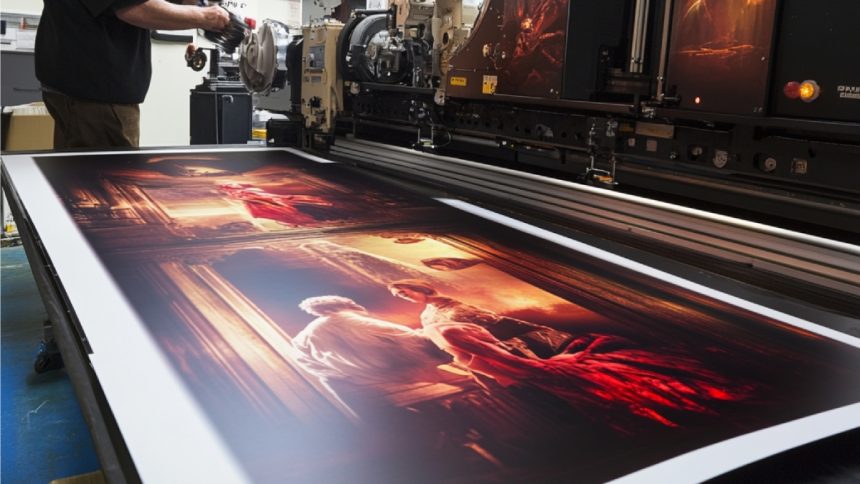Poster printing of big sizes requires large prints that are of superior quality for the display purposes. Special printing equipment, sound materials and careful structural considerations are thus necessary for this process in order to ensure that the final product is clear and impressive.
In order to print huge posters, one must have high-resolution pictures and a striking design that can be visible from afar. To ensure that the best outcomes are achieved, the appropriate printer and additional elements like thick paper or canvas should be used. By being flexible and having a strong visual impact these posters are perfect for marketing campaigns, events, education or home decoration.
Printing Large Posters
Big posters make great scenes for occasions or functions for businesses or even personal use at home. For the most important results, make sure to use pictures in high resolutions as well as appropriate materials such as either glossy paper or matte paper.
A conventional printer can be used for printing massive posters at home or professional services can be employed for better quality. Professional printers offer better color accuracy and a wider range of sizes for a polished look.
Poster Design Essentials
The must have poster design elements consist of strong colors, legible typefaces and good quality pictures. An effective design attracts attention and conveys a message at once.
In order to read from afar, it is necessary to moderate the arrangement of writing and imagery. Always keep the audience in mind to create a poster that stands out and serves its purpose.
DIY Poster Printing
In-house, there several means by which posters of high standards can be produced but DIY printing is among the most liked. This is a feasible method of creating unique designs for events, unique graphics for promotional materials, or customized decorative items in your own house.
Home vs. Pro Printing
Home poster printing is a budget-friendly option that lets you print designs using your own printer. However, it may lack the professional quality and finish that a commercial service provides.
Professional poster printing services offer higher quality, better color accuracy, and a wider range of paper options. This choice is ideal for businesses and events where polished and durable posters are needed.
Choosing Poster Paper
It is very important to choose the appropriate poster paper which helps in attaining the desired appearance and toughness. Some of the choices are glossy papers which have bright colored inks, matte papers that are non-reflective, and textured canvas paper. Decide on a type of a paper based on where it will be displayed and what effect you wish to bring out.
Avoiding Print Mistakes
- Utilize Images that are High-Resolution: In order to have neat and clear prints, make sure your images are at least 300 DPI.
- Examine Size and Bleed: Confirm the measurement and incorporate bleed to eliminate white borders post-trimming.
- Proofread Text: Double-check for typos and errors before printing.
- Calibrate Colors: Use color profiles to ensure accurate color reproduction.
- Test Print: Print a small test copy to check quality and make adjustments if needed.
Budget-Friendly Printing
Smart yet reasonably priced alternatives in printing that do not compromise on quality. Use affordable materials and compare prices from different printers to save money. Opt for bulk printing or DIY methods for additional savings on poster printing.
Posters for Marketing
For marketing purposes, posters provide a formidable means of luring attention and advertising event or items. Your poster must be conspicuous therefore employ striking illustrations along with unambiguous communication.
To effectively reach your target audience you should locate your marketing posters in areas where there are many people.
Using Word for Posters
Using Word for posters is a simple way to create basic designs with text and images. It’s an easy option for those who don’t have advanced design software.
To ensure quality, set your page size correctly and use high-resolution images. While Word is useful, professional design software can offer more advanced features for complex posters.
Advanced Printing Tips
- Set your printer to at least 300 DPI for crisp and detailed images.
- Calibrate your monitor to match the colors in your print accurately.
- Use ICC profiles to ensure your colors print as expected.
- Select paper types that enhance your print’s intended finish and durability.
- Print a test sample to identify and fix any issues before printing the final version.
Best Large Format Printers
High resolution and extension colour ranges for professionals are characteristics of the best large format printers. This makes them very versatile for different projects because they can take care of different paper sizes and types. Look for features like precision ink systems and durability to ensure long-lasting, sharp results.
Online Poster Printing
You can just upload your design and have it printed and shipped straight to you through online poster printing. It’s a convenient option for high-quality materials and professional finishes. Compare services so that you can find the best price and delivery options that meet your needs.
Educational Poster Tips
The educational posters should have a readable and comprehensible design that focuses on instructive information. To make learning interesting, utilize vivid headers, uncomplicated words, and captivating graphics. Ensure that the layout is orderly and devoid of messiness so that the students can understand the material quickly.
Conclusion
To enhance clarity, it’s important to begin with high definition pictures adding appropriate papers and printers. Best results are obtained when posters produced at home or via a professional printer are made in such a way that they look clearer and more organized.
Catchy posters that communicate effectively may be designed by adhering to proper procedures along with employing quality materials. With adequate preparation and detail orientation, large posters can yield an impressive impact.
Lynn Martelli is an editor at Readability. She received her MFA in Creative Writing from Antioch University and has worked as an editor for over 10 years. Lynn has edited a wide variety of books, including fiction, non-fiction, memoirs, and more. In her free time, Lynn enjoys reading, writing, and spending time with her family and friends.















